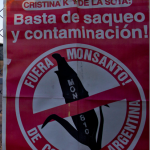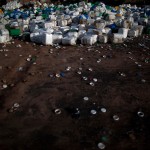Potential effects of agrochemicals in Argentina
Agrochemical spraying in Argentina has increased ninefold, from 9 million gallons in 1990 to 84 million gallons today. Yet the South American nation has a hodgepodge of widely ignored regulations that leave people dangerously exposed, and chemicals contaminate homes, classrooms, and drinking water. Doctors and scientists are warning that uncontrolled spraying could be causing health problems across the nation.
Soybeans ready for harvest are bathed in afternoon light near Rawson, in Buenos Aires province, Argentina on April 16. American biotechnology has turned Argentina into the world’s third-largest soybean producer, but the chemicals powering the boom aren’t confined to soy, cotton, and corn fields. They routinely contaminate homes and classrooms and drinking water. A growing chorus of doctors and scientists is warning that their uncontrolled use could be responsible for the increasing number of health problems turning up in hospitals across the South American nation. (Natacha Pisarenko/Associated Press)
Empty agrochemical containers including Monsanto’s Round Up products lay discarded at a recycling center in Quimili, Santiago del Estero province, Argentina on May 2. Instead of a lighter chemical burden in Argentina, agrochemical spraying has increased ninefold, from 9 million gallons in 1990 to 84 million gallons today. Glyphosate, the key ingredient in Monsanto’s Round Up products, is used roughly eight to ten times more per acre than in the United States. Yet Argentina doesn’t apply national standards for farm chemicals, leaving rule-making to the provinces and enforcement to the municipalities. (Natacha Pisarenko/Associated Press)
 Girls use slingshots next to a biotech soybean plantation in Avia Terai, in Chaco province, Argentina on May 31. The country’s entire soybean crop and nearly all its corn and cotton have become genetically modified in the 17 years since St. Louis-based Monsanto Company promised huge yields with fewer pesticides using its patented seeds and chemicals. Instead, the agriculture ministry says agrochemical spraying has increased ninefold, from 9 million gallons in 1990 to 84 million gallons today. (Natacha Pisarenko/Associated Press)
Girls use slingshots next to a biotech soybean plantation in Avia Terai, in Chaco province, Argentina on May 31. The country’s entire soybean crop and nearly all its corn and cotton have become genetically modified in the 17 years since St. Louis-based Monsanto Company promised huge yields with fewer pesticides using its patented seeds and chemicals. Instead, the agriculture ministry says agrochemical spraying has increased ninefold, from 9 million gallons in 1990 to 84 million gallons today. (Natacha Pisarenko/Associated Press)
Camila Veron, 2, born with multiple organ problems and severely disabled, stands outside her home in Avia Terai, in Chaco province, Argentina on March 31. Doctors told Camila’s mother, Silvia Achaval, that agrochemicals may be to blame. It’s nearly impossible to prove that exposure to a specific chemical caused an individual’s cancer or birth defect, but doctors say these cases merit a rigorous government investigation. “They told me that the water made this happen, because they spray a lot of poison here,” said Achaval. (Natacha Pisarenko/Associated Press)
Activist Oscar Alfredo Di Vincensi talks on a cell phone inside his tent during his one-man hunger strike demanding that agrochemical spraying not be allowed within 1,000 meters of homes, in the main square of Alberti, in Buenos Aires province, Argentina on April 16. Earlier this year, Di Vincensi stood in a field waving a court order barring spraying within 1,000 meters of homes in his town of Alberti; a tractor driver doused him in pesticide. (Natacha Pisarenko/Associated Press)
Aixa Cano, 5, who has hairy moles all over her body that doctors can’t explain, sits on a stoop outside her home in Avia Terai, in Chaco province, Argentina on April 1. Although it’s nearly impossible to prove, doctors say Aixa’s birth defect may be linked to agrochemicals. In Chaco, children are four times more likely to be born with devastating birth defects since biotechnology dramatically expanded farming in Argentina. . (Natacha Pisarenko/Associated Press)
Former farmworker Fabian Tomasi, 47, shows the condition of his emaciated body as he stands inside his home in Basavilbaso, in Entre Rios province, Argentina on March 29. Tomasi’s job was to keep the crop dusters flying by quickly filling their tanks but he says he was never trained to handle pesticides. Now he is near death from polyneuropathy. “I prepared millions of liters of poison without any kind of protection, no gloves, masks or special clothing. I didn’t know anything. I only learned later what it did to me, after contacting scientists,” he said. (Natacha Pisarenko/Associated Press)
To view TEN more photographs that are part of this story go to:
http://www.boston.com/bigpicture/2013/10/agrochemical_spraying_in_argen.html












